
Nowadays, more and more people are beginning to accept and appreciate Traditional Chinese Medicine (TCM). However, during the process of learning about TCM, many become confused by the Five Elements, especially when encountering concepts like Metal generating Water, Water generating Wood, Fire controlling Metal, and Wood controlling Earth.
In fact, the Five Elements are not as obscure as they seem. They are not only a part of TCM but also belong to the entire world and the universe. Once you truly understand the essence of the Five Elements, everything becomes much simpler.
In the foundational theories of TCM, the Five Elements are Wood, Fire, Earth, Metal, and Water, which correspond to the five forces of dispersal, communication, transformation, convergence, and storage, respectively. These elements interact through relationships of generation, control, and transformation.
1. The Five Forces in Nature
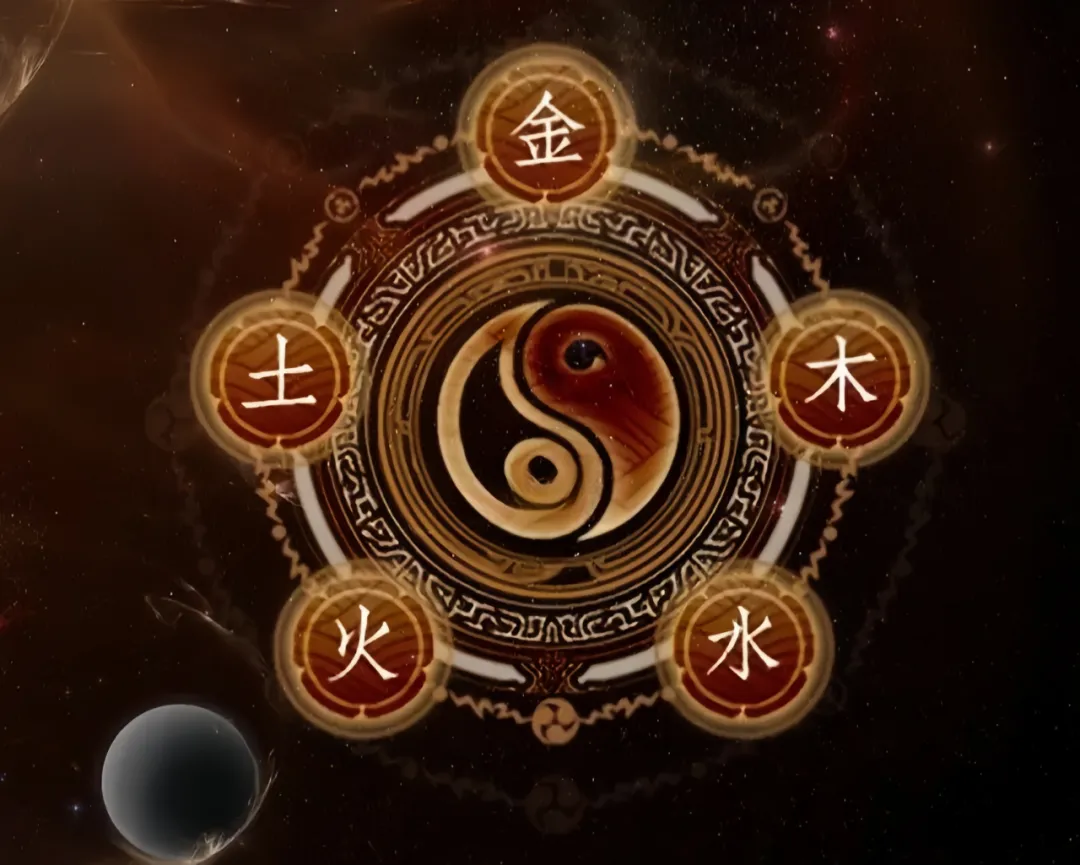
The complex world is fundamentally composed of Metal, Wood, Water, Fire, and Earth. The relationships and transformations among these five forces can be clearly illustrated through the process of rain formation.
The gentle rain during the Qingming Festival, the torrential downpours of summer, and the lonely drizzle of autumn are common weather patterns. But how does rain actually form? Simply put, the process begins with the sun’s heat being absorbed by the sea, rivers, and underground water. As the heat accumulates in the water, it reaches a certain temperature, causing the water to evaporate into vapor, rise into the sky, and form clouds. Under certain conditions, these clouds disperse, resulting in rain.
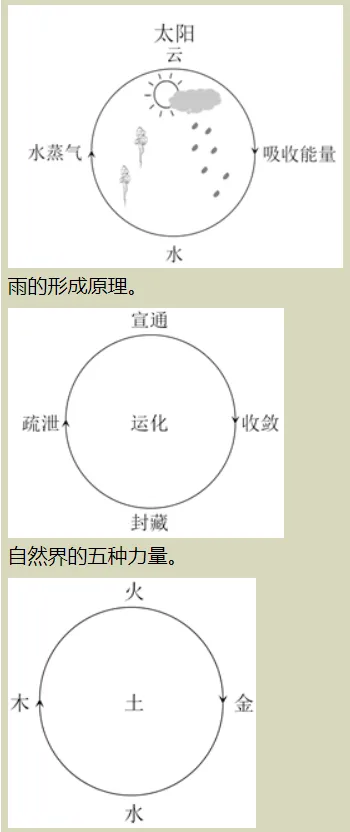
The formation of rain exemplifies the mutual transformation of the five energies. The sun’s heat provides energy to the Earth, demonstrating the ability of communication.
Although the sun’s temperature is high, we do not feel it intensely when sunlight reaches the ground because the water and other substances on Earth can absorb heat. This ability to absorb energy is known as convergence.
When heat is absorbed by water, it temporarily stores energy, which reflects the ability of storage.
This storage capacity ensures that animals, plants, stones, soil, and water in nature maintain a certain temperature. However, the storage capacity of water is limited. Once energy is stored to a certain extent, water will turn into vapor, and this rising energy is the force of dispersal.
Another force is transformation, which regulates the conversion and speed of other forces. When surface water has stored energy to a certain level, it begins to transform into vapor and disperse. This process is regulated by transformation, allowing for a gradual change. Without this function, water could suddenly turn into gas or remain unchanged.
It is the transformation of these five forces that leads to the occurrence of rain. Energetic substances exert the force of communication, transferring energy to substances with lower energy levels, which is called convergence; during convergence, substances store energy, and this storage ability is called storage; when storage reaches a certain level, lower-energy substances transition from receiving energy to supplying energy, at which point the supplying ability has not yet reached the strength of communication, leaning more towards a dispersal force; this accumulating dispersal force eventually becomes the power of communication.
The difference between dispersal and communication is that dispersal leans more towards flow and has a stronger push, while communication is more about supplying energy and has a warmer force. These four forces form a circular motion, with transformation existing among these four forces, thus placing it in the center of this circle. This circle is what Huang Yuanyu often refers to when explaining medical principles.
The larger circular motion is centered around the Earth’s surface, with an entire year (twenty-four solar terms) representing a cycle of time.
The famous Bai ethnic medical scholar Peng Ziyi, in his work “The Ancient Chinese Medicine of Circular Motion,” describes the circular motion of the sun’s heat rising and falling on the Earth’s surface during the twenty-four solar terms:
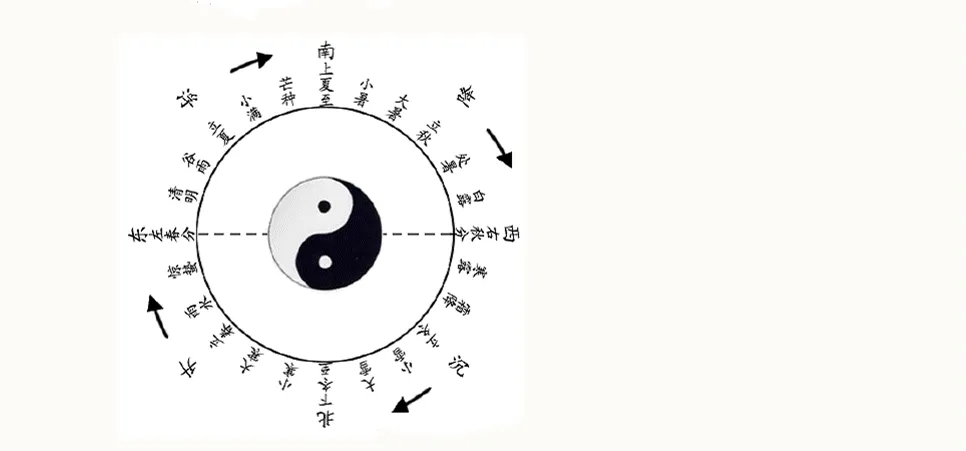
▲ Diagram of the Circular Motion of the Twenty-Four Solar Terms
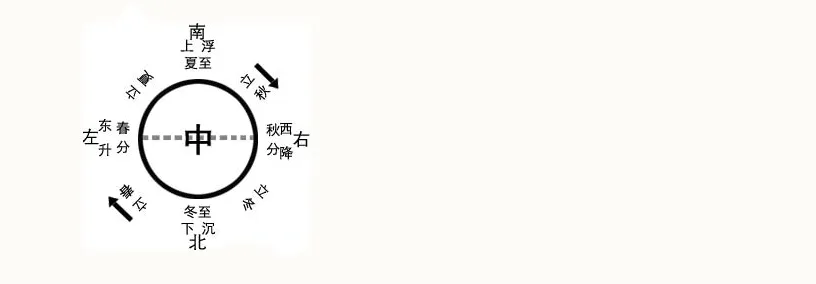
▲ Simplified Diagram of the Circular Motion of the Twenty-Four Solar Terms
It is evident that our seemingly complex Earth is actually governed by these five forces. The force of convergence is called Metal, and everything related to convergence belongs to Metal.
For example, the process of rain is a manifestation of the convergence force of Metal, while the lungs can gather external energy, thus the lungs belong to Metal in the Five Elements. Everything related to storage belongs to Water… By using these five forces to categorize the world around us, we can classify all things into the Five Elements.
Under the transformation of Earth, Metal converges into Water’s storage, and when Water’s storage reaches a certain level, Wood’s dispersal occurs. Wood accumulates heat and transforms into Fire, while Fire encounters Metal and converges. Understanding the generation of the Five Elements becomes much easier.
Control is a state of opposition; the control among the Five Elements is not simply one element overpowering another. Sometimes it is a mutual restraint, such as Water controlling Fire, where Water can extinguish Fire, but only because the current storage capacity of Water is greater than the communication capacity of Fire.
If Water is less than Fire, Fire can quickly evaporate Water. Therefore, it is important not to absolutize the generation and control of the Five Elements, as this is very helpful for learning TCM.
Why are the names Metal, Wood, Water, Fire, and Earth used to summarize the Five Forces?
In the eyes of our diligent and wise ancestors, these five substances best represent the meaning of the Five Elements.
For instance, the continuous growth of trees fully embodies the force of dispersal and generation, while Earth, positioned between Heaven and Earth, allows the sun’s light and heat to be transmitted underground, and the growth of trees requires the nourishment of Earth, thus Earth can well explain what transformation is. Metal, being heavier than the other four substances, represents the force of descent and convergence.
We can use the Five Elements to interpret the mysteries of the human body and also categorize all things in the world into the Five Elements.
Classification table of the attributes of the Five Elements:
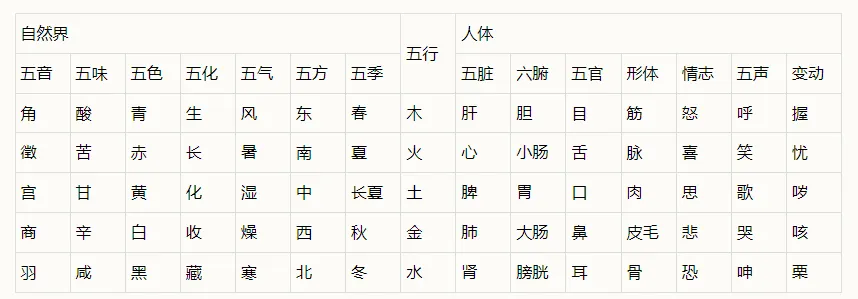
2. The Regulation Mechanism of the Five Elements
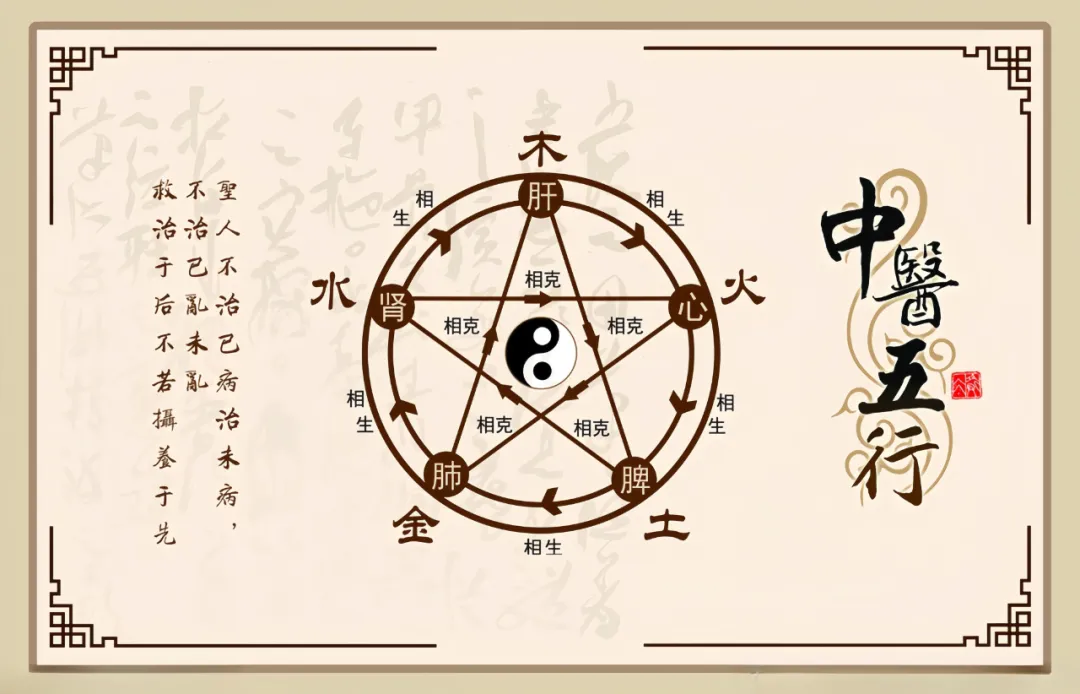
The normal regulation mechanism of the Five Elements: generation, control, and transformation.
The laws of generation and control among the Five Elements represent the automatic regulation mechanism of the Five Elements system under normal conditions.
1. The Law of Generation
Generation refers to the mutual support, growth, and promotion among the Five Elements, which is called the generation of the Five Elements.
The order of generation among the Five Elements is: Wood generates Fire, Fire generates Earth, Earth generates Metal, Metal generates Water, and Water generates Wood.
In the relationship of generation, any element has both “generating me” and “I generate” aspects. The “Nanjing” compares this to the relationship between “mother” and “child.” The one that generates is the mother, and the one that is generated is the child. Therefore, the relationship of generation among the Five Elements is also called the “mother-child relationship.”
For example, in the case of Fire, the one that generates “me” is Wood, which can generate Fire, thus Wood is the mother of Fire; the one that is generated is Earth, which Fire can generate, thus Earth is the child of Fire, and so on.
2. The Law of Control
Control refers to the mutual restraint and suppression among the Five Elements, which is called the control of the Five Elements.
The order of control among the Five Elements is: Wood controls Earth, Earth controls Water, Water controls Fire, Fire controls Metal, and Metal controls Wood.
This controlling relationship is also endless; if Wood receives Metal’s convergence, it will not scatter; if Water receives Fire’s suppression, Fire will not blaze; if Earth receives Wood’s dispersal, Earth will not become wet; if Metal receives Fire’s warmth, Metal will not converge; if Water receives Earth’s infiltration, Water will not moisten, all are the marvelous uses of natural qi.
In the relationship of control, any element has both “controlling me” and “I control” aspects. The “Huangdi Neijing” refers to this as the relationship of “what is overcome” and “what is not overcome.” The one that controls is “what is not overcome,” and the one that is controlled is “what is overcome.” Therefore, the relationship of control among the Five Elements is also called the relationship of “what is overcome” and “what is not overcome.” For example, in the case of Earth, the one that controls “me” is Wood, thus Wood is the “not overcome” of Earth. The one that is controlled is Water, thus Water is the “overcome” of Earth, and so on.
In the aforementioned generation and control relationships, any element has both “generating me” and “I generate,” as well as “controlling me” and “I control” aspects. For example, in the case of Wood, the one that generates “me” is Water, and the one that is generated is Fire; the one that controls “me” is Metal, and the one that I control is Earth.
3. The Law of Transformation
The relationship of transformation among the Five Elements is a combination of the generation and control relationships. Generation and control are inseparable aspects. Without generation, there can be no occurrence and growth of things; without control, normal changes and developments cannot be maintained.
Therefore, there must be control within generation (transformation within control) and generation within control (transformation within generation). The opposite and complementary nature of these relationships is necessary to maintain and promote relative balance and coordinated development. The relationship of generation and control among the Five Elements, which includes control within generation and generation within control, is called transformation.
The laws are: Wood controls Earth, Earth generates Metal, Metal controls Wood; Fire controls Metal, Metal generates Water, Water controls Fire; Earth controls Water, Water generates Wood, Wood controls Earth; Metal controls Wood, Wood generates Fire, Fire controls Metal; Water controls Fire, Fire generates Earth, Earth controls Water.
From the perspective of generation, Wood can generate Fire, which means “the mother comes to care for the child,” but Wood itself is also generated by Water. This balanced relationship of “generating me” and “I generate” is crucial. If there is only “I generate” without “generating me,” it will lead to excess, similar to an imbalance between income and expenditure. On the other hand, the relationship between Water and Fire is one of control, so within generation, there is also the implication of control, ensuring that generation and control maintain a dynamic balance.
From the perspective of control, Wood can control Earth, and Metal can also control Wood (I control, controlling me), while the relationship between Earth and Metal is one of generation, thus forming the cycle of Wood controlling Earth, Earth generating Metal, and Metal controlling Wood (child repaying mother’s debt). This indicates that the control among the Five Elements is not absolute; within control, there must be generation to maintain balance. In other words, the controlled element has a counteracting effect, so when excessive control occurs, it can still maintain a normal balance and coordinated relationship.
The laws of generation, control, and transformation are normal phenomena in the development and change of all things, and in the human body, they represent a normal physiological state. In this opposing and complementary relationship of generation and control, we can also see that the pseudo-coordination and balance among the Five Elements are relative. The process of generation and control is also the process of growth and development of things.
During this process, there will inevitably be instances of excess and deficiency. The emergence of these situations is itself a further regulation of generation and control. Thus, a new balance is once again achieved.
This cyclical movement of seeking balance within imbalance, and balance being immediately replaced by new imbalance, continuously drives the change and development of things. The theory of the Five Elements uses this principle to explain the normal changes in climate and ecological balance in nature, as well as the physiological activities of the human body.
3. The Five Elements in Humans
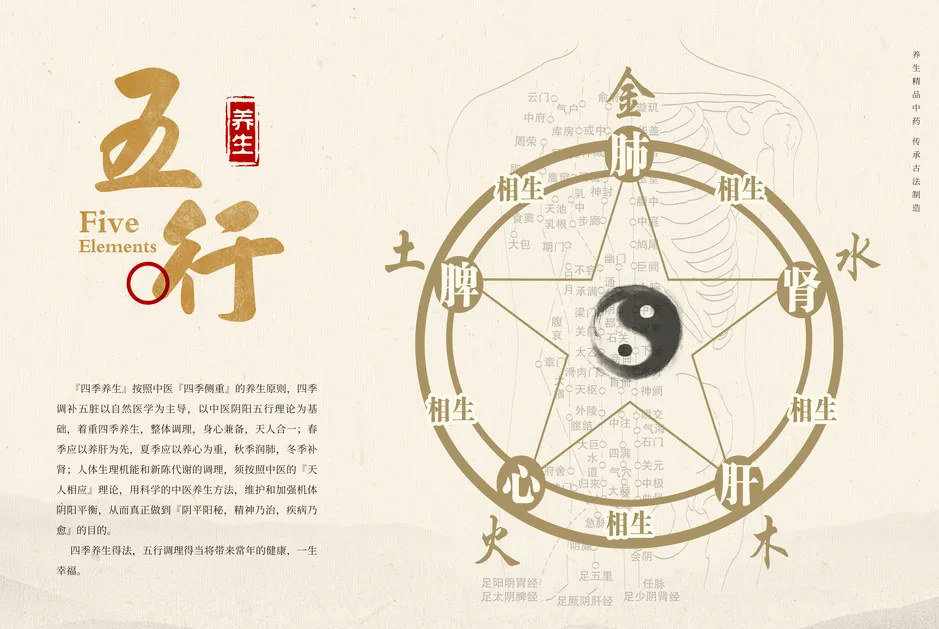
Humans are a combination of Yin and Yang, composed of energy and the material that carries energy. To coordinate the complex functions of the body, the energy within the human body transforms into different forms with the assistance of matter.
Daily activities such as walking, eating, playing, exercising, and thinking all require energy consumption. Thus, a portion of the energy in the human body directly manifests its supplying nature, which we refer to as “Fire.”
Impurities and waste need a force of dispersal to push them from generation to elimination. The flow of blood in the vessels also requires a pushing force. Therefore, some energy in the human body transforms to exhibit dispersal properties, which we call “Wood.”
To prevent excessive accumulation of energy in the body that could lead to “explosions,” some energy is converged and stored within matter. We refer to the process of convergence as “Metal” and the process of storage as “Water.”
The Yang energy and Yin matter in the human body are replenished by food and water, and the transformation of food and water into Yin and Yang requires a force of transformation, which is also derived from energy changes. We refer to the energy that performs the function of transformation as “Earth.”
To accomplish various complex physiological and psychological activities, energy exists in the human body in the forms of Metal, Wood, Water, Fire, and Earth, and they form a complete system. This system is the Five Elements circular motion system we derived from the process of rain.
The Earth is a combination of energy and matter, and the human body is also a combination of Yin and Yang. In the Earth, substances with high energy transmit energy to surrounding substances, which can accept and store energy. When energy accumulates in matter to a certain extent, it will burst forth. The Yang energy and Yin matter in the human body naturally move and change in the same way.
Thus, it is undeniable that the energy and matter in the Earth operate according to the laws of the Five Elements circular motion, and the operation of Yin and Yang in the human body must also follow the same circular motion laws.
Even more astonishing is that the laws of humans and nature are not only the same but also follow each other. For example, a person’s feelings of affection tend to awaken more easily in spring, leading to greater interest in new things and a tendency to express love, which is why many people choose to marry in spring; during summer, people are more energetic and capable of creating miracles in their work, which is why major events like the Olympics and World Cup are often scheduled in summer; in autumn, people tend to feel more melancholic, missing their hometown and loved ones, and their enthusiasm for work diminishes compared to summer; winter is the best season for sleeping, with some people preferring to sleep without eating, while many animals choose to hibernate during this season.
The planning of a year begins in spring, and the planning of a day begins in the morning. People often feel refreshed in the morning, as if they are bathed in spring breezes; noon is the time of day when energy is at its peak, which is why we tend to eat more at noon; in the afternoon, people often feel lazy and prefer to gather with close friends over tea and snacks; after a long day of work, after dinner, taking a bath, we all go to sleep.
The changes in energy follow an ancient and unchanging circular motion law. Both nature and human energy change according to this circular motion law, and the laws of the human body are in harmony with nature. Therefore, as long as we clarify and thoroughly explore the laws of energy movement, combined with the idea of the unity of heaven and man, we can uncover the mysteries of the human body and naturally resolve health issues. This is TCM, the TCM of the unity of heaven and man.
Change your mindset!
Change unhealthy habits!
Take care of yourself, starting now!

Latest Courses

Beidou Qixing is the pivot of creation, the master of gods and humans, with the power to revive the dead and eliminate disasters.All human lives and bodies are under the control of their respective life stars.Therefore, it is essential for individuals to purify their body and mind on their birth date and various fasting days, burn incense, recite scriptures, and worship their life star to eliminate sins, attain longevity, and stay away from calamities.We sincerely invite you to join our Chaoshen Li Dou event. For details, please click to read more → What is Chaoshen Li Dou? Why is worshipping Dou so effective in eliminating all misfortunes?

The Journey to Enlightenment ☯ Heart Moon
